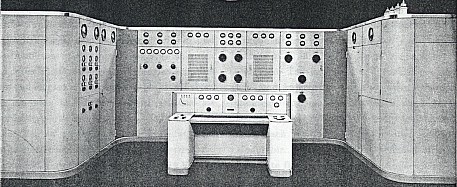| GENERAL DESCRIPTION |
 5 kW TROPICPROOF SHORTWAVE BROADCAST TRANSMITTER
5 kW TROPICPROOF SHORTWAVE BROADCAST TRANSMITTER| TUBE COMPLEMENT | |||||
| RF stages | AF stages and modulator | Rectifiers | |||
| Number | Type | Number | Type | Number | Type |
| 2 | PAL 12/15 | 2 | PE 06/40 | 2 | 506 |
| 2 | PB 3/1000 | 1 | EB 4 | 11 | DCG 4/1000 |
| 2 | PE 1/80 | 3 | EBC 3 | 6 | DCG 5/2500 |
| 2 | PE 04/10 | 1 | EL 5 | 2 | 1561 |
| 4 | CC 2 | 1 | EL 3 | ||
| 8 | EZ 4 | ||||
| 2 | 1561 | ||||
| THIS TYPE OF TRANSMITTER IS INSTALLED IN THE FOLLOWING COUNTRIES | |||||
| ITU | Country | ITU | Country | ||